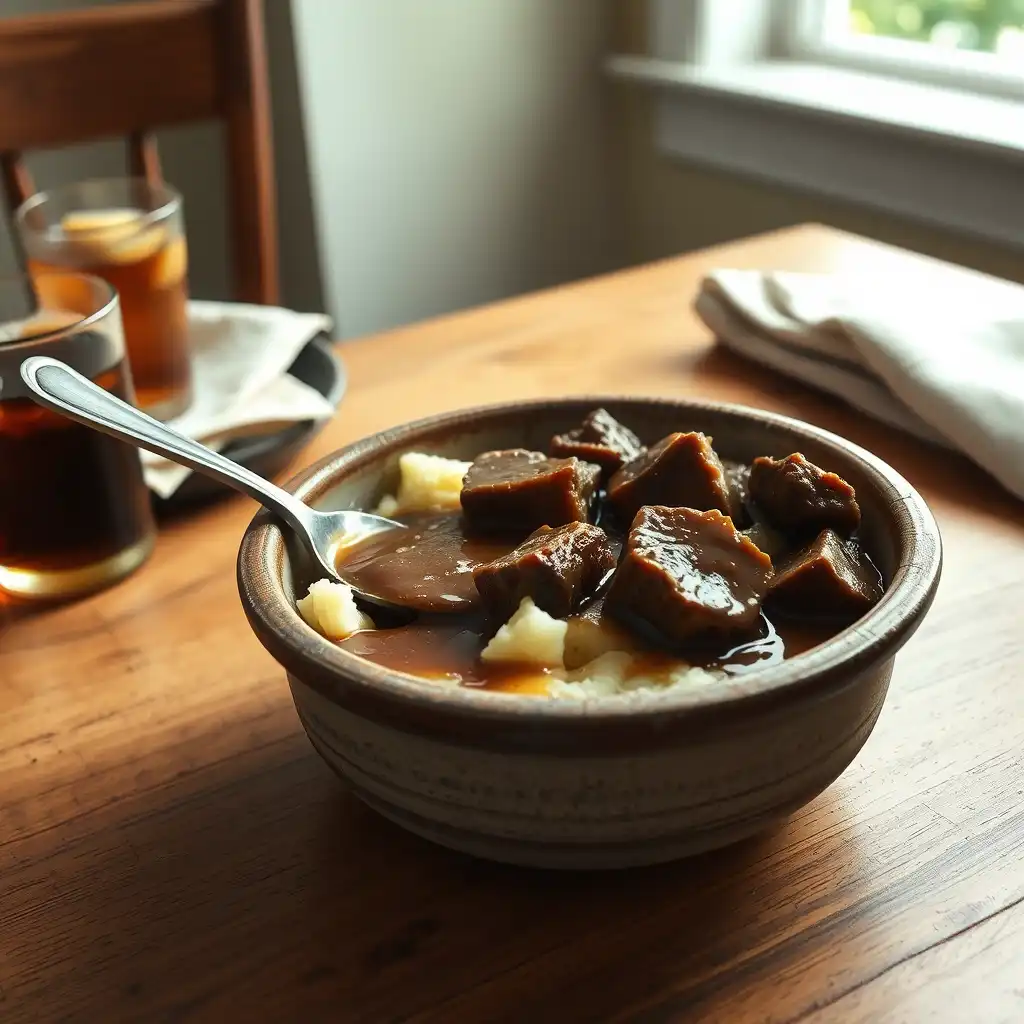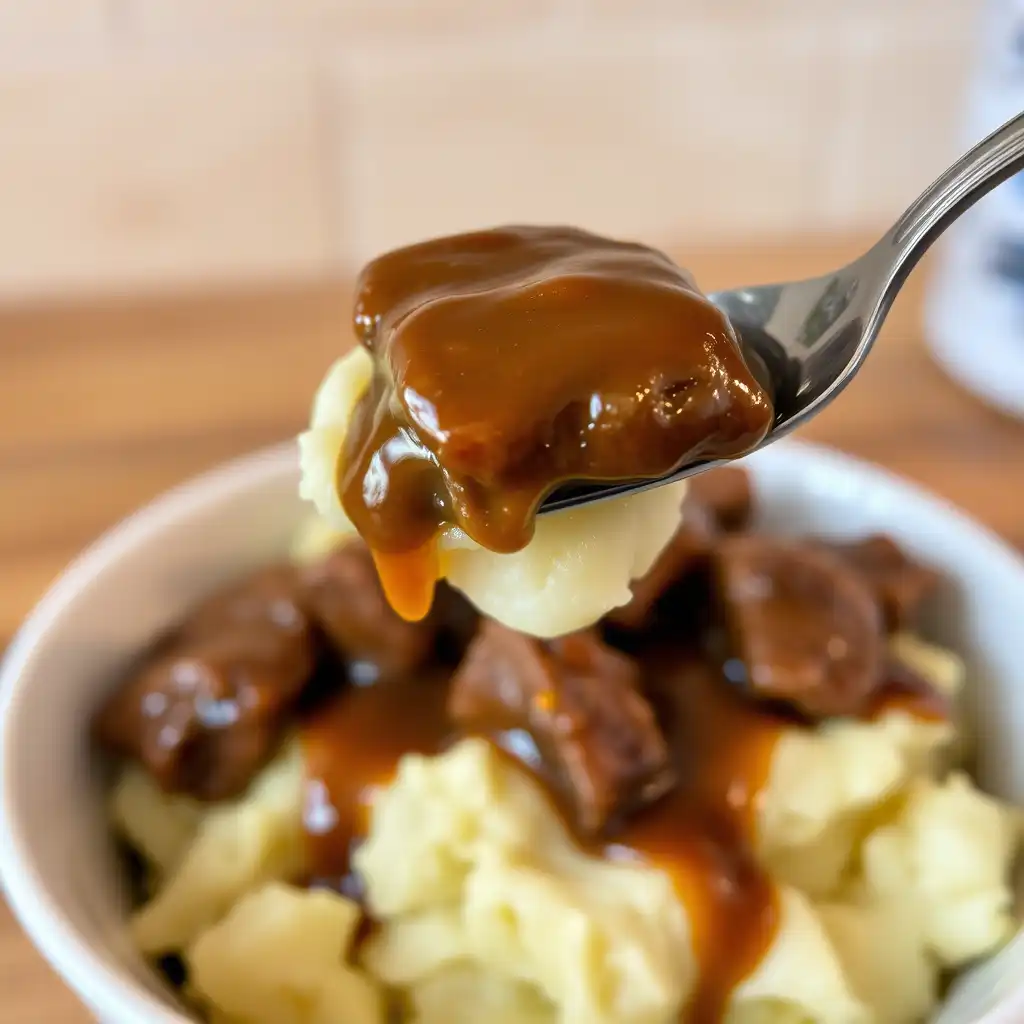Let me tell you somethin’—the first time I tossed beef tips into a slow cooker, I thought, “This is either going to be brilliant or a dry, sad mess.” I was wrong. It turned out to be rich, spoon-tender magic. A meal that hugs you from the inside out. You know those days when you need dinner to cook itself while you go live your life? This is that recipe. But it ain’t just lazy food—it’s smart food. And it tastes like you worked for it.
Slow Cooker Beef Tips & Gravy is a classic comfort dish. But don’t mistake comfort for basic. What makes this one shine is the layering of flavors—the deep browning of the beef, the slow coaxing of the gravy, the silky finish that coats every bite of meat. It’s rustic, yes, but also refined in its own humble way.
We’re not just dumping stuff in a pot and calling it dinner. There’s intention here. Thought. A little science. And a whole lot of flavor.
Ingredients & Substitutions
Beef Tips – Start with well-marbled cuts. Chuck roast is a solid choice. Cut it into 1.5″ chunks. Avoid pre-cut “stew meat” unless you’re absolutely sure of its origin. Often it’s odds and ends that don’t cook evenly.
Salt & Pepper – Don’t skip this step when browning. Seasoning early builds layers. Kosher salt, not table salt. Trust me, there’s a difference.
All-Purpose Flour – Just a dusting before searing helps develop a golden crust and thickens your gravy later. If gluten’s a no-go, use sweet rice flour—it holds up well and keeps things smooth.
Oil (Neutral, like Canola or Vegetable) – For searing. Don’t use olive oil here—it’s too delicate and can get bitter at high heat.
Yellow Onion – Sliced thin so they melt into the gravy. Red onions get too sweet. White onions get too sharp. Yellow is just right.
Garlic (3 cloves, minced) – Fresh, always. Jarred garlic tastes like it came from a dentist’s office.
Beef Broth (low-sodium) – Gives you control. High-sodium broth messes with balance.
Worcestershire Sauce – Brings umami. The kind that hugs your tongue and makes you go “mmph.”
Soy Sauce (just a splash) – Not traditional, but deepens the savory profile. Bonus: helps with browning and color.
Bay Leaf – Whole. Remove it later. Adds that background “something” that you’d miss if it wasn’t there.
Fresh Thyme (or ½ tsp dried) – Woody, herbaceous. If using dried, crush it between fingers to wake it up.
Mushrooms (optional) – Baby bellas work best. Add richness. Skip if you hate mushrooms—don’t force it.
Cornstarch + Water (for slurry) – Thickens the gravy at the end. You can use arrowroot powder if you’re paleo-minded.
Step-by-Step Instructions
1. Sear the Beef
This ain’t optional. Brown your beef in a hot skillet with a touch of oil. Don’t crowd the pan or it’ll steam. Sear in batches. The crust? That’s flavor gold.
2. Sauté the Aromatics
Toss onions in that same pan—don’t you dare clean it first. Let ’em soak up all that beefy fond. Add garlic just before onions are soft, or it’ll burn and turn bitter.
3. Build the Base
Transfer the beef and onions to your slow cooker. Deglaze the pan with a splash of broth. Scrape every bit off the bottom. That’s flavor you don’t wanna leave behind.
4. Add the Liquid Love
Pour in the rest of the broth, Worcestershire, soy, herbs, and bay. Cover and cook on LOW for 6–8 hours or HIGH for 4–5. Low is better. Patience makes perfect.
5. Thicken the Gravy
Whisk cornstarch with cold water. Add it during the last 20–30 minutes. Crank it to high if it’s not thickening fast enough.
6. Taste & Adjust
Always taste before serving. Add more salt if needed. A splash of vinegar can brighten things if it tastes flat.
Common Mistakes
- Overcrowding the sear. Don’t rush it.
- Not seasoning early.
- Using too much thickener—gravy turns gluey.
Variations
- For spice? Add ½ tsp cayenne.
- For depth? A tablespoon of tomato paste with the onions.
- For luxury? Stir in 2 tbsp of heavy cream at the end. It’s not traditional, but wow.
Cooking Techniques & Science
Searing = Maillard Reaction
That browning you see? That’s science doing its thing. The Maillard reaction builds complexity—rich, roasted notes that simmer into the gravy later.
Slow Cooking = Collagen Breakdown
Chuck roast is full of connective tissue. Cooking it low and slow turns that into gelatin. That’s what gives the gravy body and the meat its fall-apart texture.
Flour vs. Cornstarch
Flour thickens as it cooks, and adds flavor when seared onto the beef. Cornstarch, added at the end, gives a glossy finish without muting flavors.
Layering = Better Flavor
This recipe’s success isn’t from a single big move—it’s from a dozen small ones. Season early, brown well, deglaze, simmer slowly, adjust late. That’s how good cooks cook.
Tools That Help
- A heavy skillet or Dutch oven for searing.
- A 6-quart slow cooker, ideally with a “Keep Warm” setting.
- A silicone whisk to avoid scratching the cooker when thickening.

Serving & Pairing Suggestions
Presentation Matters
Spoon the beef and glossy gravy over mashed potatoes, wide egg noodles, or creamy polenta. Top with chopped parsley. Or don’t. But the green really pops.
Bread is Your Friend
Thick gravy demands bread. A crusty sourdough or even a simple dinner roll will do.
Side Dishes
- Roasted carrots with thyme and honey.
- Green beans sautéed in garlic butter.
- A tangy cucumber salad to cut through the richness.
Drinks
Pair it with a peppery Zinfandel or a malty brown ale. If you’re off the sauce, a chilled black tea with lemon balances nicely.
Leftovers?
Better the next day. Reheat gently in a saucepan with a splash of broth. Serve on toast for a fancy open-faced sandwich situation.
Conclusion
Slow Cooker Beef Tips & Gravy isn’t just a set-it-and-forget-it dinner. It’s a masterclass in cooking low and slow. It teaches patience. It rewards it. It’s rich without being fussy. Comforting but layered.
Whether you’re feeding a family, meal-prepping for the week, or trying to impress someone who thinks they’ve tasted it all—this dish has your back.
If it tastes flat, adjust. If it needs heat, add some. If the meat’s tough? You didn’t cook it long enough.
Final tip? Don’t overthink it. But don’t rush it either. Good food takes time, and this one gives every second back.
FAQs
Can I use a different cut of beef?
Yep, but it’s gotta have connective tissue. Chuck is best, but round or brisket can work. Avoid lean cuts—they dry out, even in a slow cooker.
Can I make this ahead of time?
Absolutely. It’s even better the next day. Just store it in the fridge, then reheat gently with a splash of broth or water to loosen the gravy.
How do I fix gravy that’s too thin?
Use a cornstarch slurry—1 tbsp cornstarch to 2 tbsp cold water. Stir it in, then cook on high until it thickens. Don’t add dry cornstarch directly—it’ll clump like crazy.
What’s the best way to store leftovers?
Cool it first, then store in airtight containers for up to 4 days. You can also freeze it for 2–3 months. Thaw in the fridge before reheating.
Can I cook this in the oven instead?
Yup. Brown everything, combine in a Dutch oven, then cover and bake at 300°F for about 3 hours. Check halfway and add a splash more broth if it looks dry.

Olivia P. is a seasoned food blogger at Tastywink, sharing delicious, easy-to-follow recipes inspired by him passion for home cooking. With years of culinary blogging experience, he brings flavor, creativity, and a personal touch to every dish.
